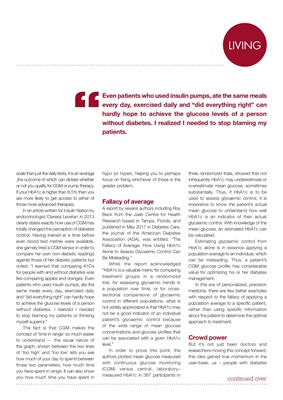
KITLIVING
continued over
scale than just the daily tests, it is an average
,the outcome of which can dictate whether
or not you qualify for CGM or pump therapy.
If your HbA1c is higher than 8.5% then you
are more likely to get access to either of
those more advanced therapies.
In an article written for Insulin Nation by
endocrinologist Claresa Levetan in 2013
clearly states exactly how use of CGM has
totally changed the perception of diabetes
control. Having trained at a time before
even blood test metres were available,
she gamely tried a CGM sensor in order to
compare her own non-diabetic readings
against those of her diabetic patients but
noted, "I learned that comparing A1Cs
for people with and without diabetes was
like comparing apples and oranges. Even
patients who used insulin pumps, ate the
same meals every day, exercised daily
and "did everything right" can hardly hope
to achieve the glucose levels of a person
without diabetes. I realized I needed
to stop blaming my patients or thinking
myself superior."
The fact is that CGM makes the
concept of 'time in range' so much easier
to understand --- the visual nature of
the graph, shown between the two lines
of 'too high' and 'too low' lets you see
how much of your day to spend between
those two parameters, how much time
you have spent in range. It can also show
you how much time you have spent in
hypo (or hyper).
Fallacy of average
A report by several authors including Roy
Beck from the Jaeb Centre for Health
Research based in Tampa, Florida, and
published in May 2017 in Diabetes Care,
the journal of the American Diabetes
Association (ADA), was entitled, "The
Fallacy of Average, How Using HbA1c
Alone to Assess Glycaemic Control Can
Be Misleading."
While the report acknowledged
"HbA1c is a valuable metric for comparing
treatment groups in a randomized
trial, for assessing glycaemic trends in
a population over time, or for crosssectional comparisons of glycaemic
control in different populations, what is
not widely appreciated is that HbA1c may
not be a good indicator of an individual
patient's glycaemic control because
of the wide range of mean glucose
concentrations and glucose profiles that
can be associated with a given HbA1c
level."
In order to prove this point, the
authors plotted mean glucose measured
with continuous glucose monitoring
(CGM) versus central, laboratory-
measured HbA1c in 387 participants in
three randomized trials, showed that not
infrequently HbA1c may underestimate or
Even patients who used insulin pumps, ate the same meals
every day, exercised daily and "did everything right" can
hardly hope to achieve the glucose levels of a person
without diabetes. I realized I needed to stop blaming my
patients."
overestimate mean glucose, sometimes
substantially. Thus, if HbA1c is to be
used to assess glycaemic control, it is
imperative to know the patient's actual
mean glucose to understand how well
HbA1c is an indicator of their actual
glycaemic control. With knowledge of the
mean glucose, an estimated HbA1c can
be calculated.
Estimating glycaemic control from
HbA1c alone is in essence applying a
population average to an individual, which
can be misleading. Thus, a patient's
CGM glucose profile has considerable
value for optimizing his or her diabetes
management.
In this era of personalized, precision
medicine, there are few better examples
with respect to the fallacy of applying a
population average to a specific patient,
rather than using specific information
about the patient to determine the optimal
approach to treatment.
Crowd power
But it's not just been doctors and
researchers moving this concept forward,
this idea gained true momentum in the
user-base, us - people with diabetes
wanted a better way of looking at how we
were doing.